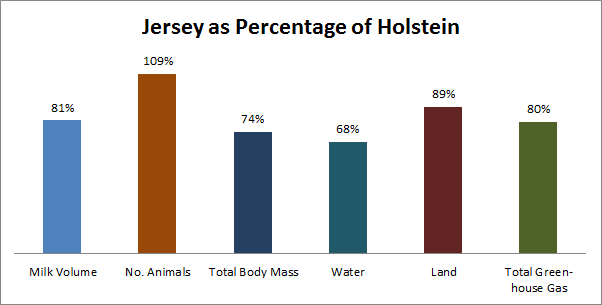Explore the advantages of Montbéliarde and Viking Red crossbreds over Holsteins in dairy production. Could crossbreeding be the secret to elevating your herd’s performance?
Ever wonder what makes one breed of dairy cow stand out more in milk production? In commercial dairies, understanding the lactation curves of different breeds can be crucial. This post focuses on Montbéliarde × Holstein and Viking Red × Holstein crossbred cows, comparing them to pure Holsteins. We analyze data from seven high-performance herds to see which crossbreds perform better.
Comparing these crossbreds to Holsteins isn’t just academic—it’s vital for dairy farmers aiming to boost productivity. Montbéliarde crossbreds are known for their muscular build and high fat and protein yields. At the same time, Viking Reds are praised for their health and fertility. By examining these traits, we offer insights for better herd management.
We will analyze the lactation curves of Montbéliarde and Viking Red crossbreds vs. Holsteins across multiple lactation periods. Key metrics like 305-day production, peak production, and milk, fat, and protein yield persistency will be explored. Our findings could reveal significant advantages of crossbred cows over Holsteins, reshaping dairy farming strategies.
Introduction to Dairy Crossbreeding: Montbéliarde and Viking Red vs. Holstein
Diving into dairy crossbreeding involves understanding specific breeds. The Montbéliarde and Viking Red cattle are critical players in this field, each offering unique strengths when crossed with Holsteins.
Overview of Montbéliarde Cattle Breed
Montbéliarde cattle, originating in France, are known for their robust health and longevity in dairy operations. Their red pied coat, strong legs, and excellent udder quality are distinctive. They were developed from local breeds and Simmental cattle in the late 19th century.
Advantages of Using Montbéliarde: These cattle have a more significant body condition, shorter stature, and less body depth during early lactation than pure Holsteins. They excel in fertility, leading to higher conception rates and producing more live calves. Their udder conformation supports better milk production with lower somatic cell counts.
Overview of Viking Red Crossbreds
Viking Red cattle are valued for adaptability, robust health, high fertility rates, and efficient milk production. With a medium frame and red coat, they have strong udders suitable for high-performance dairies. This breed results from breeding programs in Denmark, Sweden, and Finland.
Viking Red crossbreds return to peak production faster after calving and show more excellent persistency in milk production across lactations. They have superior fertility and conception rates, enhancing reproductive efficiency and profitability. While they may produce slightly less fluid milk than pure Holsteins, they often yield higher fat.
Comparison of Montbéliarde and Viking Red Crossbreds to Holsteins
| Characteristic | Montbéliarde × Holstein (MO × HO) | Viking Red × Holstein (VR × HO) | Holstein (HO) |
|---|---|---|---|
| Average Milk Yield | Similar to HO | Less than HO | Higher |
| Fat Content | Higher | Higher | Lower |
| Protein Content | Higher | Higher | Lower |
| Milk Persistency | Higher | Similar | Lower |
| Health and Fertility | Better | Better | Poorer |
| Feed Efficiency | Higher | Higher | Lower |
| Overall Profitability | Higher | Higher | Lower |
| Body Condition | Greater | Greater | Lesser |
| Reproduction Rates | Higher | Higher | Lower |
| Calving Ease | Better | Better | Lower |
Analyzing Lactation Performance and Milk Yield
| Lactation Curve Characteristics | MO × HO 2-Breed Crossbreds | VR × HO 2-Breed Crossbreds | HO Herdmates |
|---|---|---|---|
| 305-d Production (kg) | Not different | Less fluid milk | Standard |
| Peak Production (kg) | Similar | Lower | Standard |
| Peak Day of Production | Similar | Earlier | Standard |
| Persistency of Production | Higher | Similar | Lower |
| 4 to 103 DIM (kg) | Similar | Less fluid milk | Standard |
| 104 to 205 DIM (kg) | Higher | Less fluid milk | Standard |
| 206 to 305 DIM (kg) | Higher | Less fluid milk | Standard |
| Fat Production (kg) | Higher (2nd & 3rd lactations) | Higher (2nd & 3rd lactations) | Standard |
| Protein Production (kg) | Higher | Similar | Standard |
Holsteins often lead to milk yield, especially in the first lactation. They produce more fluid milk compared to Montbéliarde and Viking Red crossbreds. However, Montbéliarde × Holstein crossbreds excel in persistency, maintaining stable milk production throughout the lactation period.
The fat and protein content in milk is higher in crossbred cows. Montbéliarde × Holstein and Viking Red × Holstein crossbreds offer richer milk than pure Holsteins. This advantage holds in first and later lactations, showcasing the benefits of crossbreeding on milk composition.
Overall, the milk quality and components from crossbreds are superior. The enhanced persistency in crossbreds like Montbéliarde and Viking Red leads to consistent, high-quality milk production. This boosts milk pricing and improves dairy farm profitability, making crossbreeding an intelligent choice for modern dairy farms.
Comparing Health and Fertility
| Trait | Montbéliarde × Holstein | Viking Red × Holstein | Holstein |
|---|---|---|---|
| Fertility (Conception Rate, %) | 65 | 67 | 58 |
| Calving Interval (Days) | 380 | 370 | 400 |
| Days Open | 120 | 110 | 150 |
| Incidence of Mastitis (%) | 15 | 12 | 20 |
| Body Condition Score | 3.0 | 3.1 | 2.8 |
| Longevity (Years) | 5.5 | 6.0 | 4.5 |
Crossbred cows generally have better health than their Holstein herd mates. Montbéliarde and Viking Red crossbreds show more resistance to diseases common in dairy herds. This better health leads to longer and more productive lives.
Fertility is another strong point for Montbéliarde and Viking Red crossbreds. They have higher conception rates and better overall fertility than Holsteins. This means more efficient breeding and lower costs for artificial insemination and calving intervals.
Montbéliarde and Viking Red crossbreds also have easier calving and strong maternal instincts. These traits lead to higher calf survival rates and less labor for calving management. Better calving performance is crucial for overall herd health and efficiency.
Feed Efficiency and Overall Profitability
| Breed/Crossbreed | Feed Conversion Rate (lbs of milk/lb of feed) | Cost of Production ($/lb of milk) | Overall Profitability ($/lactation) |
|---|---|---|---|
| Holstein | 1.5 | 0.18 | 800 |
| MO × HO (2-breed) | 1.6 | 0.17 | 875 |
| VR × HO (2-breed) | 1.4 | 0.19 | 760 |
| MO × VR/HO (3-breed) | 1.55 | 0.175 | 820 |
| VR × MO/HO (3-breed) | 1.5 | 0.18 | 805 |
Crossbred cows like Montbéliarde and Viking Red typically show better feed efficiency than pure Holsteins, needing less feed per unit of milk. This leads to cost savings and improved profits for dairy farms.
Montbéliarde and Viking Red crossbreds also have lower production costs, which is vital for any dairy farm. Their higher disease resistance, better fertility rates, and enhanced feed efficiency reduce veterinary and feed expenses, making them more economical.
These crossbreds often live longer than Holsteins, especially in high-performance herds. Their robust health, increased fertility, and easier calving improve their lifespan and ensure a higher return on investment for farmers.
Why Crossbreeding Could Be the Future of High-Performance Dairy Herds
Crossbreeding can enhance high-performance dairy herds by improving lactation performance and milk yield. Over the past decade, Montbéliarde (MO) and Viking Red (VR) crossbreds have shown better milk persistency than Holsteins (HO), leading to stable milk production and healthier cows.
Crossbred cows also show higher fertility rates and better reproductive traits. They have fewer stillbirths and return to peak production faster after calving. For instance, 3-breed crossbred calves have a 4.5% stillbirth rate compared to 9% in purebred Holsteins.
Economically, crossbreeding is beneficial. Crossbred cows produce more milk solids and are more feed-efficient, reducing feed costs and increasing profitability. Their improved fertility leads to frequent calving and efficient herd replacement.
The health benefits of crossbreeding include a more robust immune system and better resistance to common ailments, leading to lower veterinary costs.
Overall, crossbreeding combines the best traits of each breed, resulting in cows that excel in milk production, health, fertility, and profitability. It offers a pathway to a more sustainable and resilient dairy industry.
Real-World Insights: Data from Seven High-Performance Herds
Based on data from 2010 to 2017, the study analyzed cows from seven top-performing herds. This included Montbéliarde (MO) × Holstein (HO), Viking Red (VR) × HO 2-breed crossbreds, MO × VR/HO, VR × MO/HO 3-breed crossbreds, and their pure Holstein herd mates. The research aimed to compare their lactation performance.
Using random regression (RR) and the Legendre polynomial method, the lactation curves showed vital differences. MO × HO 2-breed crossbreds produced similar fluid milk as Holsteins but had better persistency in milk, fat, and protein. The VR × HO 2-breed crossbreds had lower fluid milk production but higher fat and protein yields in later lactations. MO × VR/HO 3-breed crossbreds also showed better milk production persistency than Holsteins.
The main takeaway is that crossbred cows, especially those with Montbéliarde genetics, tend to outperform Holsteins in certain traits over time. This improved persistency can lead to greater efficiency and profitability, suggesting crossbreeding as a valuable strategy for high-performance dairy herds.
The Bottom Line
The research on dairy crossbreeding compared Montbéliarde and Viking Red crossbreds with Holstein cows, focusing on performance and profitability. This study used data from seven high-performance herds to analyze lactation yields, health, fertility rates, and feed efficiency.
Pros and Cons of Montbéliarde and Viking Red Crossbreds: Montbéliarde (MO) and Viking Red (VR) crossbreds offer better body condition, higher fertility, and more consistent lactation. MO × HO crossbreds had higher protein production across all lactation stages, and both MO and VR crossbreds showed better fat production in later lactations than Holsteins. These traits can lead to greater profitability due to stable and high-quality milk solids.
However, VR × HO crossbreds generally produced less fluid milk in the first lactation than Holsteins. While other factors may balance this out, it’s something to consider for dairies focused on initial higher fluid milk outputs.
Overall, crossbreeding offers a future path for sustainable dairy farming. Breeds like Montbéliarde and Viking Red provide resilience, better fertility, and strong milk solid production. They can be vital to creating more sustainable, efficient, and profitable dairy operations as the industry faces climate and market challenges.
Key Takeaways
- Breed Performance: Montbéliarde × Holstein crossbreds showed no significant difference in fluid milk production compared to Holsteins, except for increased milk persistency.
- Enhanced Persistency: Montbéliarde × Holstein crossbred cows demonstrated superior persistence in milk, fat, and protein production during their first lactation.
- Higher Fat Production: Both Montbéliarde × Holstein and Viking Red × Holstein crossbreds exhibited higher fat production during their second and third lactations than Holstein cows.
- Improved Protein Production: Montbéliarde × Holstein crossbreds outperformed Holsteins in protein production across all lactation periods.
- Crossbreeding Advantages: Crossbred cows potentially offer better persistency and production traits compared to pure Holsteins, particularly in high-performance herds.













